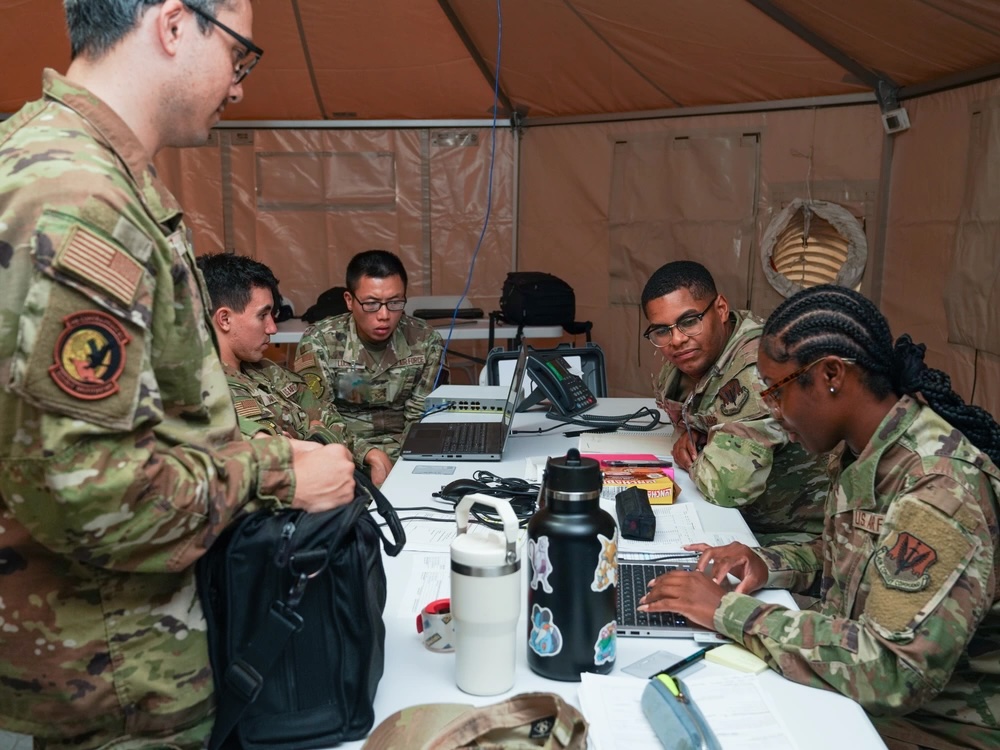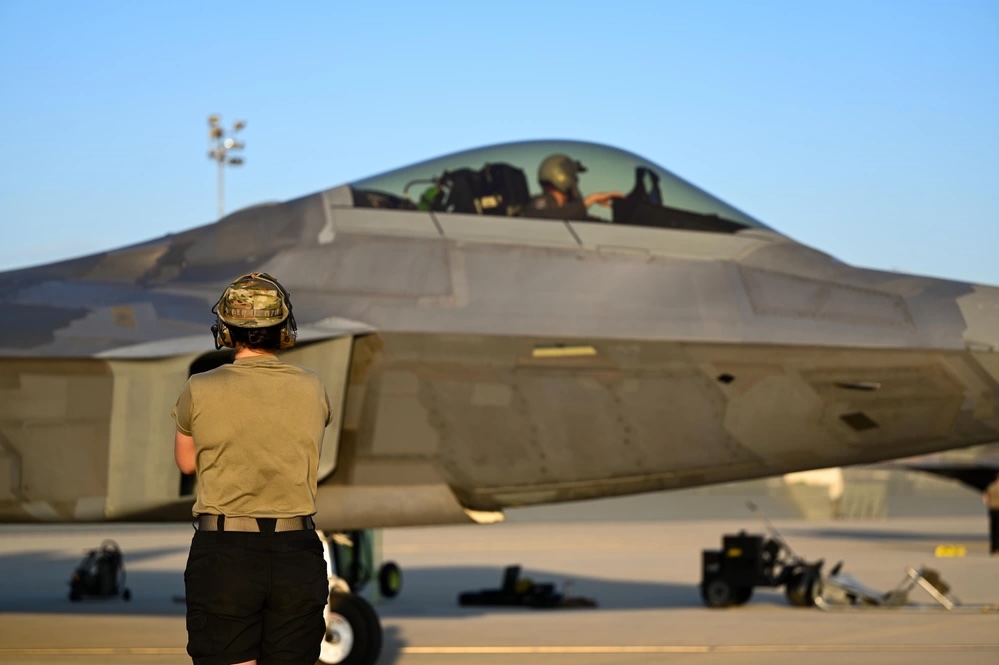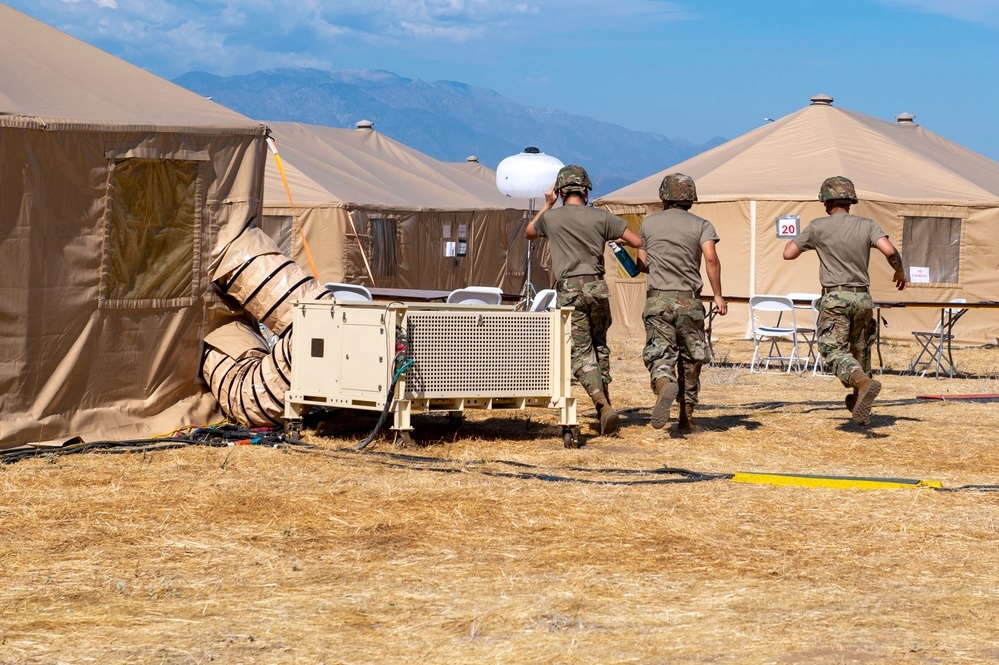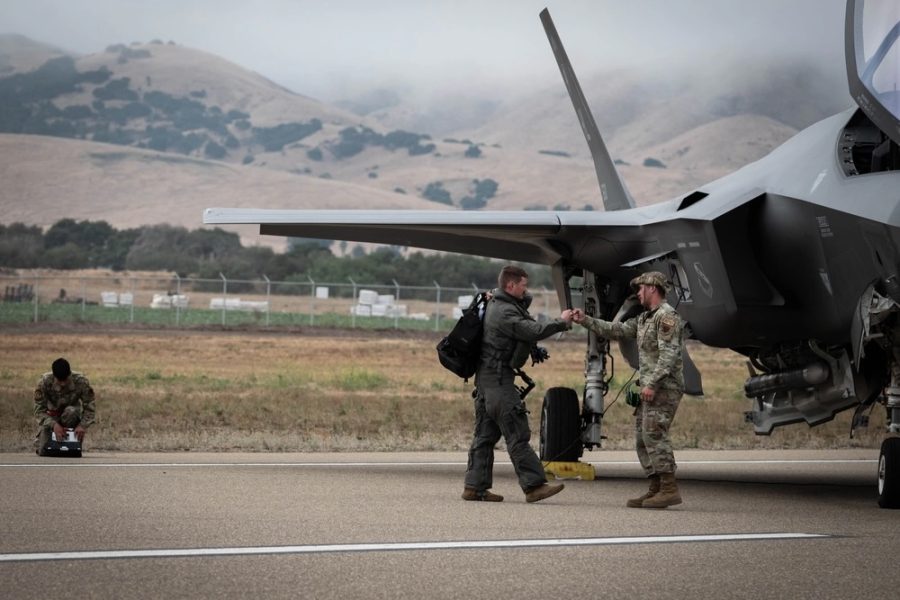The 9th Reconnaissance Wing has more than 60 years of experience gathering intelligence from the air, but two military exercises earlier this month saw Airmen from the wing do something completely different: command and control fighter and transport aircraft as part of a massive exercise across the western U.S.
“I brought a bunch of reconnaissance Airmen into a situation where they are being asked to think like a fighter wing or a mobility wing,” said Col. Keagan L. McLeese, commander of the 9th RW, which acted as the 9th Air Expeditionary Wing at the exercises. “It’s so far outside the box … that’s the point of the exercise, find our failings and learn from them.”
Known as Bamboo Eagle and Agile Flag, the exercises forced Airmen to project airpower from unfamiliar, unequipped airfields across the West Coast. That meant air and ground crews for fighter and bomber aircraft had to work closer than ever with mobility aircraft and support staff in order to stand up airfields, then quickly relocate if targeted by a simulated missile strike.
“Traditionally a Red Flag or a Red Flag-like exercise stresses aircraft, aircrew, maintainers, and flightline-adjacent capabilities like munitions, fuels, avionics, et cetera,” Lt. Gen. Adrian L. Spain, deputy chief of staff for operations, said at an Aug. 1 media roundtable.
Bamboo Eagle, by contrast, “is designed to stress the entire ecosystem,” he said. “From all the support forces up to and including a wing commander and their staff in their ability to command and control a wide array of force elements under their command across dispersed locations.”

Making that happen fell to the command and control force elements (C2FEs). The C2FEs made sure the mission generation force elements (MGFEs)—in this case, the fighters, bombers, and their maintainers—had the guidance, food, supplies, and other equipment they needed to accomplish their mission.
Both C2FEs and MGFEs are part of the new Air Force Force Generation Model, a system where standardized force elements are available at regular intervals so joint force commanders can recognize and easily integrate the elements into their operations.
“The idea is that you can take any wing, ask them to deploy, and then they can integrate and work with any other unit and still provide that care, feeding, and guidance to enable that unit to go execute,” said Maj. Caleb, who served as the director of operations for the 9th Air Expeditionary Wing at Bamboo Eagle. A reconnaissance pilot, his last name was withheld for security reasons.
But part of being interoperable is knowing who to operate with, and that’s a change for new C2FEs like the 9th Reconnaissance Wing Airmen.
“It was really new working with that Mobility Air Force, because I didn’t have any idea of how an actual resupply of either personnel or equipment actually worked,” said Caleb. “I just knew that at some point, a C-130 or a C-17 would show up at the base and it would have our equipment, or it would have our replacements.”
But at Bamboo Eagle, Caleb and his colleagues at the C2FE had to contend with the nitty-gritty that makes airpower possible: are the bomb carts and power generators loaded properly so that C-17s can safely fly them to a spoke? Once it gets there, are there enough forklifts to quickly download cargo before the C-17 can be targeted by a missile? If the spoke is targeted, how do Airmen request C-130s to take them and their equipment to a new one?
Answering those questions often means knowing who to talk to. For example, there are organizational emails to contact for requesting mobility aircraft, but there are separate processes for requesting C-130s versus C-17s. And if it has to get done fast, it helps to know who to call.
“I can email this org box, and someone will eventually see it and get to it,” Caleb said. “But who is on the other line that I can actually call and talk to another human and say, ‘Hey, this is the urgency or priority that I need for them to understand’ and they say, ‘OK, awesome. Let me process that for you.’”
The scale of Bamboo Eagle proved a challenge even for more experienced hands. While the 9th Air Expeditionary Wing provided command and control for a group of “hub and spoke” airfields from its temporary headquarters at Edwards Air Force Base, Calif., the 23rd Wing performed the same task for a separate group of hubs and spokes from its temporary headquarters at the Mojave Air and Space Port about a 30-minute drive west of Edwards.
Maj. David Tipton, the operations director for the 23rd Wing at Bamboo Eagle, said that as a rescue and attack unit with its own HC-130s, the 23rd has some experience working with mobility assets and knowing what they need. But the size and speed of Bamboo Eagle was something else.
“The Air Force has been doing mobility logistics for a really long time,” Tipton said. “What we’re doing here is trying to abbreviate the timeline so that we can very quickly enable logistics over such a long distance without impacting the fight. What used to take a few days, we’re trying to do in a matter of hours so we can keep generating combat airpower.”
Indeed, Caleb recalled having to direct two C-130s to fly maintainers and equipment to an austere airfield so they could refuel and rearm a pair of F-22s waiting there; get the F-22s off to the next base so they could swap pilots in time for their next mission; then move the maintainers and gear to their next mission, all while balancing the air crews’ limited duty days and getting it all done with just 24 to 36 hours’ notice.
“If you had asked me to do that a week, two weeks before Bamboo Eagle, I would have given you a blank stare. I would not have known what to do,” Caleb said. “But learning through Bamboo Eagle and Agile Flag taught me who to talk to, where to look, who to work with in order to accomplish these overarching goals that the Air Force needs us to be able to execute.”

And it was not as if a C2FE could focus on one movement at a time; in the vast scale of Bamboo Eagle, planners had to juggle multiple priorities and contingencies. As the F-22 process unfolded, a real-world crisis emerged when the generator for an MGFE died, leaving the Airmen in 105-degree heat without electricity to cool their tents or purify their water.
That meant Caleb and his colleagues had to find out how much water the Airmen had left, calculate how long that would last in the heat, and how to get the generator fixed as soon as possible. They managed to find the right contractors to get the generators back online within about six hours, but the emergency made the exercise a very real experience.
“Man, for those six hours, it was stressful,” Caleb said. “It ended up working out really well, but it was one of those things where we’re dealing with a real-world concern, and then on top of that we also need to coordinate for this movement to happen.”
Running into those uncomfortable moments and still finding a way to accomplish the mission was part of the goal for Bamboo Eagle and Agile Flag, explained Chief Master Sgt. Steven G. Creek, command chief master sergeant for the 9th Reconnaissance Wing.
“It really has them run through some problem-solving techniques and challenges that they’ve probably never had to run through in their career,” he said. “That’s kind of the beauty of an exercise like this: it’s designed to make people uncomfortable, take them out of their traditional wheelhouse and put them in situations that we hope that they’re going to be able to overcome.”
Better to figure it out now than in an actual conflict, Creek added. In fact, part of the training was to make leaders practice weighing risk as if they were in an actual conflict. Caleb recalled moments where commanders had to decide between moving or sheltering their troops from an incoming missile attack or having them launch aircraft for a vital mission.
“How much risk are you willing to accept? Because at the end of the day, during wartime, we are still going to need to launch aircraft,” he explained. Plenty of exercises simulate risk for air crews, partly since flying is inherently dangerous, he said, but rarely does that simulated risk extend to ground crews.
“I think in a lot of exercises, you rarely get to put a commander in a position where he or she is accepting the risk of loss of life for their men,” Caleb said.

Bamboo Eagle has ended, but the training continues for the 9th Reconnaissance Wing back at Beale Air Force Base, Calif. The size of Beale lets Airmen practice leading notional MGFEs, albeit at a smaller scale than earlier this month, Caleb explained.
The shift to MGFEs and C2FEs is part of a larger concept called Agile Combat Employment, where the Air Force works out of small, scattered air bases instead of large ones that present juicy targets for long-range missiles. But that concept does not work without Airmen stepping outside their usual job specialties to help out with whatever the mission requires. At Bamboo Eagle, Caleb saw that in spades.
“It was really awesome seeing Airmen at every level being empowered to be problem solvers,” he said. “When things like the water situation happened, it didn’t matter who had a good idea or what rank that good idea came from. If it was a good idea, we were going to go with it, because the purpose is to keep our personnel and our equipment safe and sustained.”
It was a hot, unpredictable, and often stressful experience, but it was also the kind of meaningful adventure many people hope for when they join the Air Force, McLeese pointed out.
“When you’re a kid and you’re thinking about joining the military, you kind of think about living in a tent and roughing it a little bit in order to do combat operations,” he said. “That’s exactly what we’re doing here … and that’s why you see smiles on their faces, because you’re actually getting to do what you came into the service to do.”
